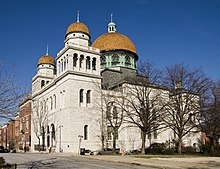
A synagogue, sometimes referred to by the Yiddish term shul and often used interchangeably with the word temple, is a Jewish house of worship. Synagogues have a place for prayer, where Jews attend religious Services or special ceremonies, have rooms for study, social hall(s), administrative and charitable offices, classrooms for religious school and Hebrew school, sometimes Jewish preschools, and often have many places to sit and congregate; display commemorative, historic, or modern artwork throughout; and sometimes have items of some Jewish historical significance or history about the Synagogue itself, on display.

Henrietta Szold was an American-born Jewish Zionist leader and founder of Hadassah, the Women's Zionist Organization of America. In 1942, she co-founded Ihud, a political party in Mandatory Palestine dedicated to a binational solution.

Marcus Jastrow was a German-born American Talmudic scholar, most famously known for his authorship of the popular and comprehensive Dictionary of the Targumim, Talmud Babli, Talmud Yerushalmi and Midrashic Literature. He was also a progressive, early reformist rabbi.

Benjamin Szold was an American rabbi and scholar.

Alois Kaiser was an American chazzan and composer, considered to be the founder of the American cantorate.
William Rosenau was a leader of Reform Judaism in the beginning of the twentieth century in the United States.
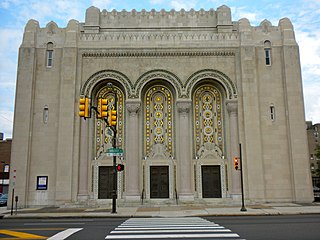
Congregation Rodeph Shalom of Philadelphia, founded in 1795, is the oldest Ashkenazic synagogue in the Western Hemisphere. It is noted historically for its leadership of the Reform Judaism among American Hebrew congregations, for its spiritual influence upon international Jewry, and for its unique 1927 Moorish Revival building on North Broad Street, on the National Register of Historic Places for many decades.

Congregation B'nai Israel is the oldest Jewish congregation in Sacramento, California. The congregation, which began as an Orthodox community, traces its history back to the California Gold Rush of 1849, when Jewish settlers gathered to observe the High Holy days. The congregation purchased its first building at 7th and L streets on September 2, 1852, making it the first congregationally owned synagogue west of the Mississippi River.
Temple Israel is the oldest synagogue in Columbus, Ohio, and a founding member of the Union for Reform Judaism. Formed as early as 1846 as the Orthodox Bene Jeshurun congregation, its first religious leader was Simon Lazarus, a clothing merchant who founded what would become Lazarus department stores.
Stephen Wise Temple is a large Reform Jewish congregation in the Bel Air neighborhood of Los Angeles, California. Founded in 1964 by the late Rabbi Isaiah Zeldin, with 35 families, the congregation grew rapidly. At various times in its history it has been stated to be the largest, or one of the largest, Jewish congregations in the world, at one time having a membership of about 3,000 families, six rabbis, two cantors and two cantorial interns, and four schools on three campuses. As of 1994 it was the second-largest synagogue in the United States. The community was founded as the Stephen S. Wise Temple. In 2014 it was renamed the Stephen Wise Temple.

Temple Israel is a Reform Jewish congregation in Memphis, Tennessee, in the United States. It is the only Reform synagogue in Memphis, the oldest and largest Jewish congregation in Tennessee, and one of the largest Reform congregations in the U.S. It was founded in 1853 by mostly German Jews as Congregation B'nai Israel. Led initially by cantors, in 1858 it hired its first rabbi, Jacob Peres, and leased its first building, which it renovated and eventually purchased.
Reverend Dr. Jacob Mayer was a European-born American rabbi who served congregations in the Reform Judaism movement in the late 19th century. He obtained the pulpit in 1874 at Har Sinai Congregation in Baltimore, founded in 1842 and the longest continually functioning congregation adhering to Reform since its inception. Mayer was forced to leave two years later amid charges that he had been an apostate who had converted to Christianity and had been a missionary in Africa, though he vigorously denied the charges.
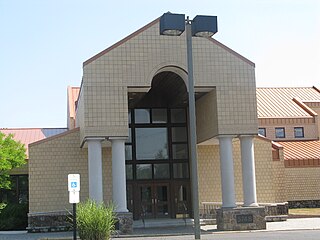
Congregation M'kor Shalom was a Reform Jewish synagogue located at 850 Evesham Road in Cherry Hill, New Jersey.

Temple Emanuel is a Reform synagogue located on the east side of Davenport, Iowa, United States. Organized in 1861, it is the oldest Jewish congregation in Iowa. It is affiliated with the Union for Reform Judaism (UAHC).

Eutaw Place Temple is a large, eclectically-styled former synagogue on Eutaw Place in the Bolton Hill neighborhood of Baltimore, Maryland. The temple was constructed to serve the German Jewish immigrant community. Originally built as a synagogue for the Temple Oheb Shalom congregation, the property was sold to the Prince Hall Masons in 1960. It was built in 1892 as the second home of the Oheb Shalom congregation, and borrows design elements from the Great Synagogue of Florence. The architect was Joseph Evans Sperry of Baltimore.
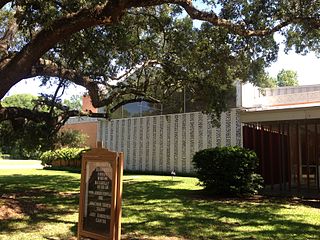
Congregation Gemiluth Chassodim known locally as "The Jewish Temple" is an historic Jewish synagogue located in Alexandria, Louisiana. Founded in 1859 by Jews from the Alsace region of France, it is one of the oldest congregations in Louisiana and one of the original founding members of the Union of American Hebrew Congregations, now known as the Union for Reform Judaism.
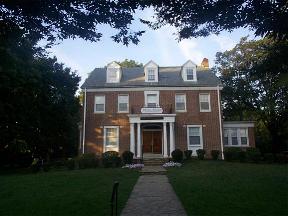
Few Jews arrived in Baltimore, Maryland, in its early years. As an immigrant port of entry and border town between North and South and as a manufacturing center in its own right, Baltimore has been well-positioned to reflect developments in American Jewish life. Yet, the Jewish community of Baltimore has maintained its own distinctive character as well.

Ahavas Shalom Reform Temple ) is an historic synagogue building located in Ligonier, Noble County, Indiana at 503 Main Street, built in 1889. It is located in the Ligonier Historic District.
